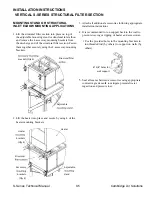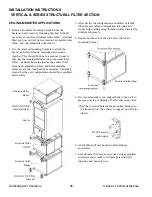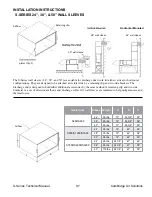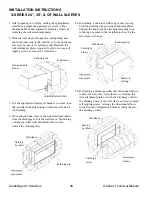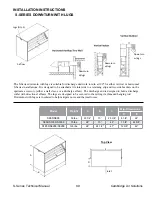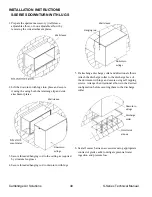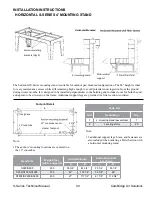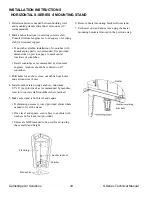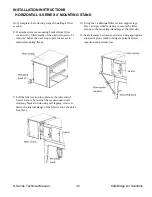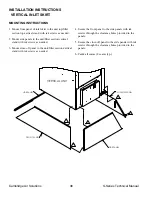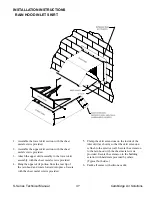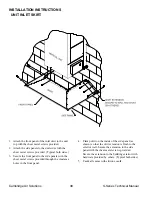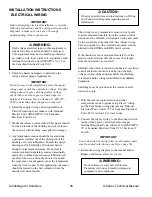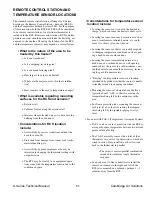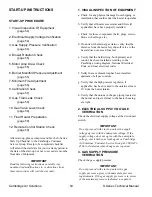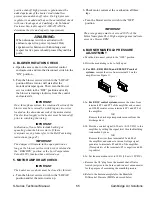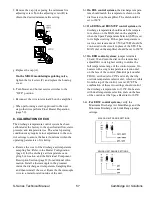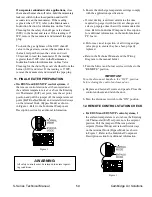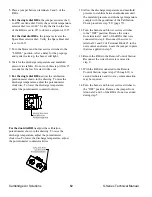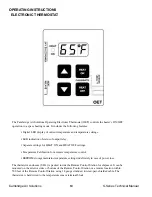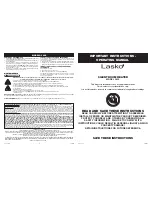
S-Series Technical Manual
49
Cambridge Air Solutions
INSTALLATION INSTRUCTIONS
GAS PIPING
IMPORTANT
Refer to the heater name plate for determining the
minimum gas supply pressure for obtaining the maximum
gas capacity for which this heater is specified. Any field-
installed components including, but not limited to, meters,
regulators, strainers and external gas trains must be
installed such that the minimum operating supply pressure
for obtaining the maximum gas capacity is provided.
IMPORTANT
Units with external gas trains must be installed so that the
equivalent distance from the outlet of the gas train to the
inlet of the heater does not exceed 4 feet.
.1. Check with the local utility or gas supplier to determine
the gas supply pressure.
CAUTION:
If the gas supply pressure is in excess of the
maximum standing pressure indicated (14” WC, or 1
PSIG, or 2 PSIG, or 5 PSIG) on the heater nameplate,
a separate positive shutoff high pressure regulator must
be added upstream of the heater’s individual manual
shutoff valve. This regulator must be vented to the
outside of the building at least 10 feet from any intake
opening. The vent pipe should be designed to prevent
the entry of water, snow, insects or other foreign
material that could cause blockage. There must be no
reduction in size of the vent piping. Depending on the
length and the configuration of the vent piping the pipe
size may need to be increased. Refer to the applicable
codes for proper sizing.
2. Properly size the gas supply piping for the rated input
capacity, per local codes, and/or the National Fuel Gas
Code, NFPA 54/ANSI 223.1 or the CAN/CSA B149
Installation Codes.
3. Make sure the supply piping is free of foreign matter and
purged.
4. Verify that the gas piping, when installed, will not restrict or
block the unit access door from fully opening.
5. Install the gas piping to the unit in accordance with
local codes or, in their absence, in accordance with the
National Fuel Gas Code, NFPA 54, NFPA 54/ANSI
223.1 or the CAN/CSA B149 Installation Codes.
IMPORTANT
A 1/8” NPT tap is supplied with the heater for measuring
the gas supply pressure. If the gas supply pressure exceeds
that indicated on the nameplate, the installer must install
a 1/8” NPT tap and high pressure manual shutoff valve
upstream of the high gas pressure regulator.
m
CAUTION:
An adequate sediment trap must be installed upstream
of all gas controls for the heater and as close to the gas
inlet connection of the heater as practical.
IMPORTANT
Many gas train components are equipped with Listed
Vent Limiters as atmospheric bleeds, however, local codes
may require that these vents and bleeds be vented to the
outdoors. If so, the vent piping should be designed to
prevent the entry of water, snow, insects or other foreign
materials that could cause blockage.
6. Apply test pressure to the supply piping system and
check for leaks. Use liquid gas detector.
m
WARNING:
Do not use flame for leak checking.
m
CAUTION:
If the test pressure is in excess of 1/2 PSIG
(3.45 KPA), the heater and its manual shutoff valve
must be disconnected from the gas supply system
during pressure testing. Failure to comply will void
warranty.
If the test pressure is less than or equal to 1/2 PSIG (3.5
KPA), the heater must be isolated from the gas supply piping
by closing its manual shutoff valve during pressure testing.
m
WARNING:
Do not attempt to start unit at this time. Premature start-
up can result in damage to equipment and components.

